"CRAFT TOURISM ECHIZEN" A Journey to Know the Essence of Handicrafts by a Chef

Hokuriku is a place where traditional crafts are alive and well. Among them, Echizen City has a particularly strong personality. That should be true, looking back on history, this area was the center of Japan's economy and culture during the Yamato period, and became the provincial capital of Echizen after the Nara period. It is deeply rooted in the climate.
Okata Otaki Shrine
This time, we have invited friends who work with us at Takigahara Farm to take us on a trip to introduce the charm of Echizen City's craft culture. This time, we have Mr. Haruta Suzuki, the chef of the hotel CRAFT & STAY, which uses an old private house. He is a sous chef at the 1-star restaurant "SORA" in Paris.
To experience the craftsmanship of Echizen City from the perspective of a chef, we first headed to Okata Otaki Shrine, the mecca of Japanese paper.
As you go further in while enjoying the atmosphere of the Imadate district where Japanese paper workshops gather, you will see a shrine.
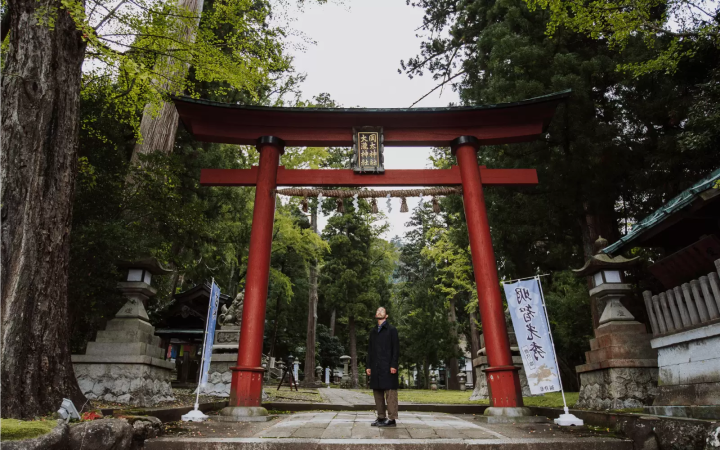
This is a shrine that enshrines Kawakami Gozen, the god of paper.
Once you step into the precincts, the tranquility unique to a shrine fills the environment.
I will share with Haruta the knowledge that I have gained while visiting the shrine about why this area has become one of Japan's leading producers of Japanese paper. The god who brought Japanese paper making to this land is a female god. Hokuriku has many female gods, just like Kikurihime of Mt. Hakusan.
Go up the stairs and beyond the gate, you will see a roof with a shape you have never seen before. And if you look closely, the whole building is carved to a tremendous level. Mr. Haruta was at a loss for words when he saw the presence of the decorations.
Even so, every time I come, the atmosphere here is different.
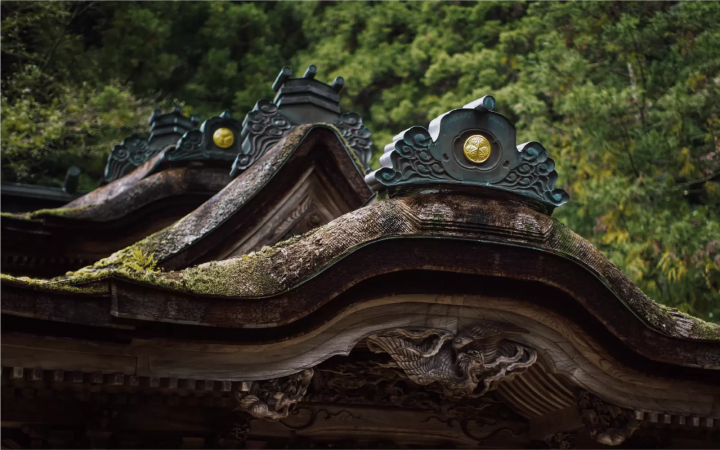
https://www.echizen-tourism.jp/travel_echizen/visit_detail/36?
Nagata Paper Mill
Next, we headed to Nagata Paper Works, a Japanese paper studio that mainly specializes in shoji paper.
Kazuya Osada, the 4th generation president, welcomed us.
Mr. Haruta kindly explained the process of making Japanese paper and his particularity while showing us around the studio. Nagata Paper Works is a workshop that has been making Japanese paper for over 100 years since its founding, specializing in fusuma paper. Mr. Nagata brushed up the technique called “Hiryu” created by the second generation, and applied it not only to fusuma but also to various products to expand the possibilities of washi.
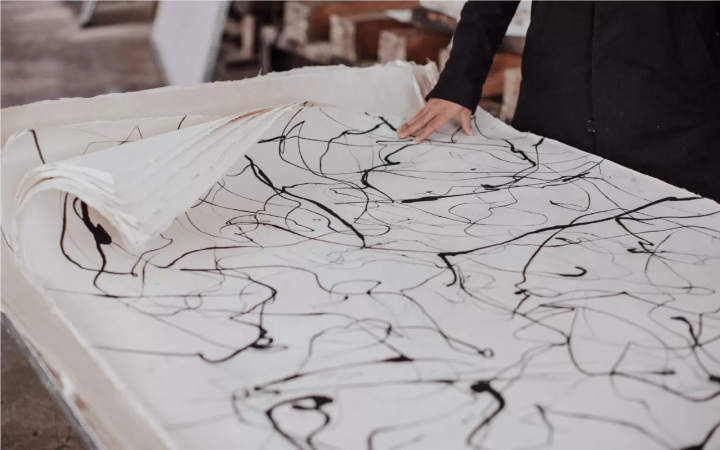
It has an atmosphere like an art piece rather than a traditional craft.
Mr. Haruta said that what left the biggest impression on Mr. Nagata's talk was, "The idea of being as natural, good for the body, and sustainable as possible." In 2019, they tried making completely additive-free paper through crowdfunding.
Usatsu Craft Museum
In the center of the production area, in the area called Washi-no-Sato-dori, where many Japanese paper-related facilities are gathered, there are the Papyrus Museum and the Udatsu Crafts Museum. Both are facilities where you can try your hand at making washi paper, but the Papyrus Hall is a collection of washi products, making it a must-visit place for those looking for washi products.
We asked Haruta to experience making paper at the Udatsu Crafts Museum.
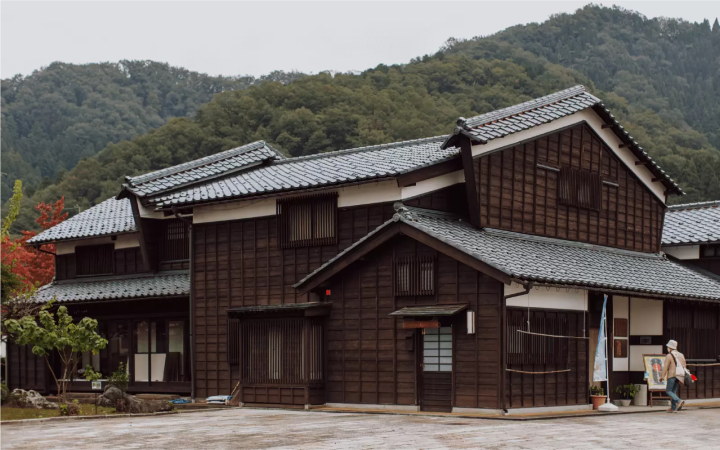
A powerful appearance with a splendid Udachi standing literally
The building, which is a relocated and restored paper-making house from the mid-Edo period, has been carefully renovated to create a comfortable environment. The overall impression is clean, and the environment is set up so that you can experience full-fledged papermaking. Haruta is finally ready to experience making paper while receiving guidance from the instructor. After failing several times, I was really impressed when I finally finished the paper beautifully. Mr. Haruta says that he was able to do well by feeling the rhythm with his body instead of trying to understand it with his head. You can send the paper you made at a later date.
https://www.echizen-tourism.jp/travel_echizen/experience_detail/27?
Ryusen cutlery
Next, head to the area where Echizen cutlery workshops gather.
Echizen Uchihamono began around 1300 when Chiyozuru Kuniyasu, a swordsmith from Kyoto, moved to present-day Echizen City in search of a land suitable for making swords, and made sickles for local farmers. It is said that The characteristics of Echizen cutlery are the traditional fire-making forging technique and hand-sharpening. It is especially famous for the ``Nimai unfolding'' method, in which two blades are stacked on top of each other, and the mawashi steel attachment, which allows you to create a fine, thin blade.
While other production areas shifted to mass production, we continued to focus on handicrafts, and as a result of the craftsmen working hand in hand, we began to receive inquiries from chefs and enthusiasts around the world. It's a growing market.
This time, we visited "Ryusen Hamono", which started commercialization of stainless steel from early among Echizen cutlery and has pioneered the field of making kitchen knives for home use.
Speaking of Ryusen cutlery, the Ryusen ring appears when materials with different hardness are layered and sharpened. We were shown around the workshop and learned about the characteristics of Echizen cutlery, how the cutlery is produced.
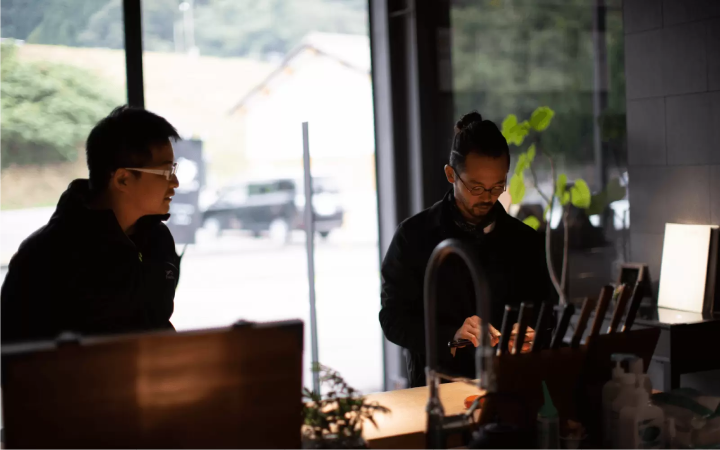
Katayama Sake Brewery
Fermentation culture, especially sake, is an important subject for me as a chef to understand the local climate. This time, we visited Katayama Sake Brewery, one of the representative sake breweries of Echizen, to talk with them.
In fact, 2020 was a big turning point in Fukui's sake environment. With the goal of making the best daiginjo, the development of a new type of sake rice called ``Sakahomare'' began in 2010, and the harvest has finished. Timing when new sake was released. Katayama Sake Brewery has also released "Tsukiha" using new rice.
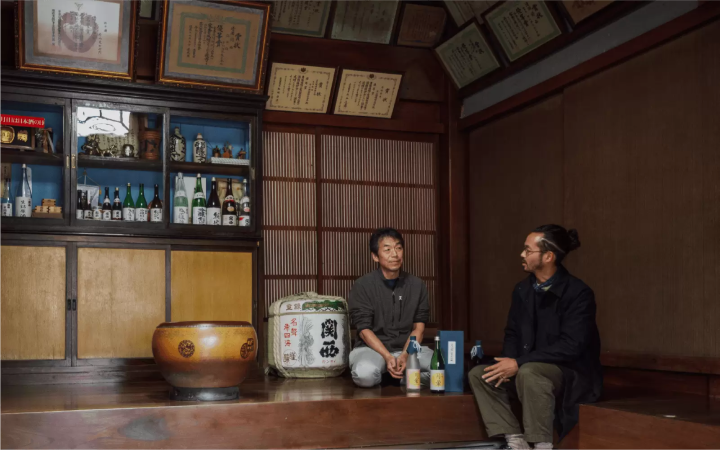
Katayama Sake Brewery is a brewery with a history that dates back to the 1700s.
The taste of "Tsukiha" was like Daiginjo, and it had a neat taste without any unpleasant taste.
Masuda Buckwheat Mill
Fukui is synonymous with soba. There are 22 strains of native buckwheat in Fukui Prefecture, but the “Masuda Soba Flour Mill” that we visited this time only handles buckwheat flour that is ground with a stone mortar from Fukui’s endemic species, including those cultivated in-house. The appeal of Echizen soba is the primitive flavor of an endemic species that has not undergone selective breeding. If you grind it with a stone mill for a long time, it will be delicious.
Mr. Masuda gave me some buckwheat flour to use at the dinner party.
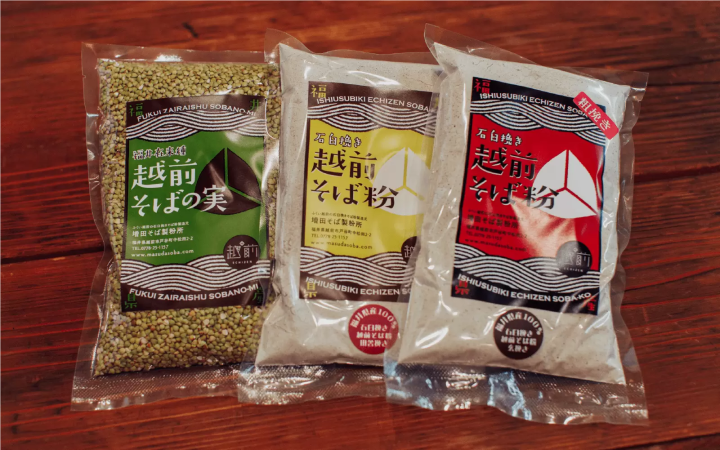
house of memories
This concludes the interview for the first day.
From here, we will gather with the Japanese paper craftsmen and have a dinner party for Mr. Haruta at the gallery "Memory House" operated by Nagata Paper Works where you can stay. Mr. Hideaki Taki, the 7th generation of Taki Paper Works, and Mr. Izumi Nagata, the 5th generation of Nagata Paper Works, participated.
I use a santoku that I borrowed from Ryusen Hamono.
Santoku is a knife that is very easy to use at home. As a cooking professional, I don't often use kitchen knives, but recently Mr. Haruta has been paying attention to the ease of use again. I will use it and handle the fish efficiently and beautifully. That should be it, I have experience of training at the famous Japanese restaurant "Ryugin".
While exchanging delicious food and Katayama Sake Brewery's halo of the moon, the flowers bloom until late.
Existence that bears the next generation of studio with long history each other. A craftsman is a bug of a lot of work. We didn't stop talking about work until late at night.
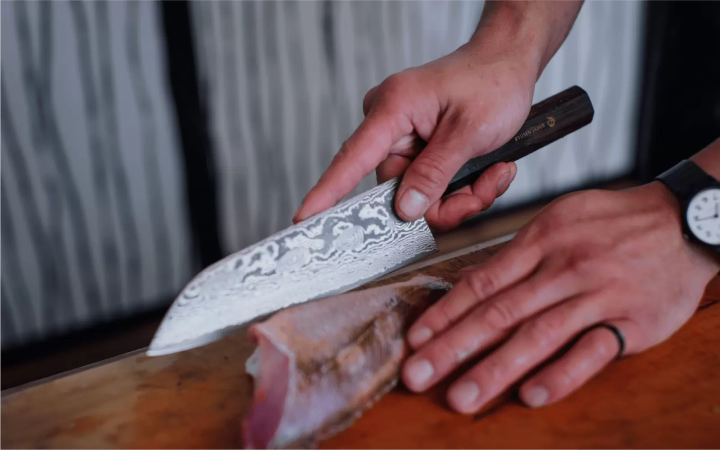
https://museum-1288.business.site/
Taki Paper Factory
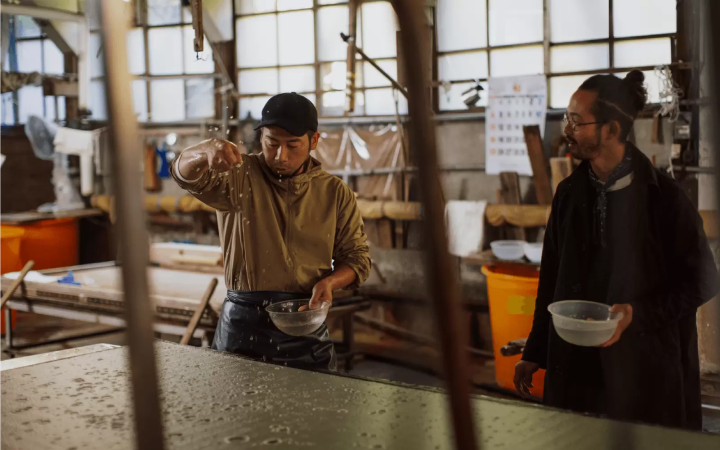
On the second day, we started with Taki Paper Works, which was founded in 1875 and mainly manufactures large paper. The morning of the craftsman was early, even though we hadn't been able to talk until late the day before. Mr. Taki, who started work early in the morning and has already warmed up, demonstrated his specialty technique. I have Mr. Haruta do it too, and I can see that even the simple act of sprinkling water requires the skill of a craftsman.
Yesterday's Mr. Nagata and Mr. Taki's workshop each specialize in large-format paper such as fusuma paper. It seems that the environment where this size is made on a daily basis is about Echizen. The collaboration with Dutch contemporary artist Theo Jansen, which started in 2018, was also due to this large-format technology. It is now an environment that attracts attention from all over the world.
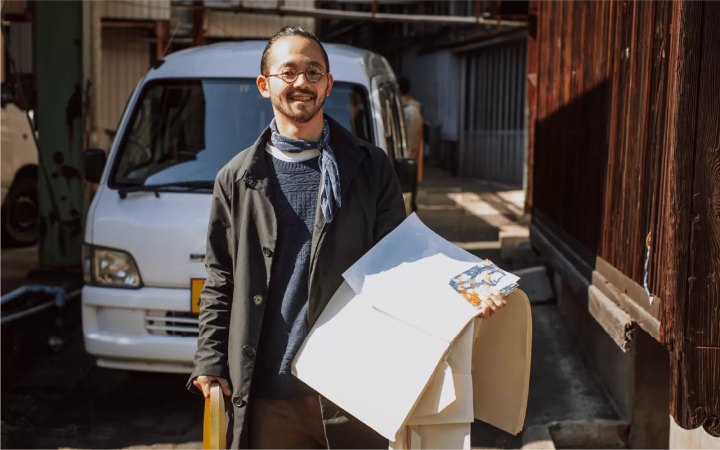
Mr. Haruta is delighted to receive a piece of scrap from Mr. Taki Washi paper has a high affinity for the food environment, such as menus.
Takefu Knife Village Cooperative
Next, head to the Takefu Knife Village Cooperative, which was also the venue for the 2020 Millennium Future Craft Festival. After traveling around Echizen City for two days, I realized that the entire Echizen City area is dotted with workshops involved in craftsmanship, like a village. The distance is just right for driving around.
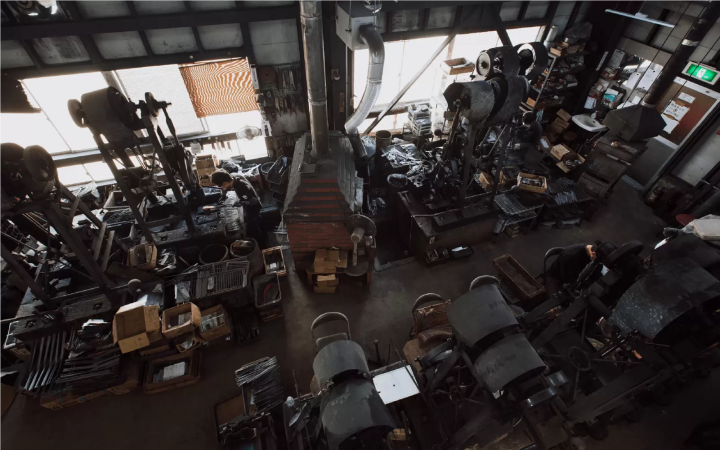
Takefu Knife Village is a facility jointly operated by 12 workshops that brings together the manufacturing and sales environments for Echizen cutlery. More than 40 craftsmen are working, 17 of them are traditional craftsmen. Furthermore, the upper age group is 80 years old and the lower age group is 18 years old. It is a rare facility that literally has a sustainable business environment.
Mr. Toya, a traditional craftsman, showed us around the facility, which opened a new annex this year, and brought us closer to the blades. In the new building, the shop function has been strengthened so that you can see and touch the products of each company in one place. Overall, the design has done a good job, and it has become a facility with the impression that the craftsmanship has been updated. The gallery displays knives for a variety of purposes, and is very worth seeing.
The main building is designed to overlook the workshop, so you can see the hands of the craftsmen.
Haruta who bought Knife Village's original small santoku
A lightweight and compact knife that makes you want to cook anytime.

https://www.takefu-knifevillage.jp/
Return to Takigahara and immediately cook with a kitchen knife. Together with my colleague Reina, I ate with Ryusen Hamono's cutlery.
Yoichi Uchiki / Botanically Photography and Planning
Over 20 years of experience in marketing at foreign companies and pharmaceutical trading companies. After being involved in a traffic accident and undergoing long-term medical treatment, he decided to put his activities into context design. After moving from Kamakura with the launch of TAKIGAHARA FARM and completing his activities as a regional revitalization cooperation corps, he is currently engaged in activities such as craft soundscapes while having multiple occupations as a photographer, planner, and herbalist. I like to mix people, herbs, everything.
Echizen wisdom ~Proposing a new tourism, a journey of wisdom.~ A town that has inherited the skills and spirit of its predecessors for 1,500 years. Echizen, the entrance to the "Koshi no Kuni" ruled by an ancient king. A place of wisdom where cutting-edge technology and culture first flowed in from across the Sea of Japan and became the origin of Japan's profound manufacturing. In the traditional industries that coexist with the nature of the land and in the people who live here, the universal wisdom that human beings want to bring to the next 1000 years is alive. Here and now, there is a future born from exchanges that transcend national borders and time and space. A new quest to find light. Welcome to Echizen.
The contents on this page may partially contain automatic translation.




![[2025 Edition] A thorough guide to getting to the Echizen Great Buddha(Echizen Daibutsu)](https://resources.matcha-jp.com/resize/720x2000/2023/05/10-137958.webp)



























![[THE BLOSSOM KYOTO] Awaken your senses with the Kyoto aesthetic that lives on in the hotel](https://resources.matcha-jp.com/resize/720x2000/2025/07/01-237865.webp)


